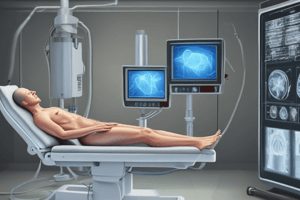Podcast
Questions and Answers
What does the transmit/receive switch direct during transmission?
What does the transmit/receive switch direct during transmission?
- Driving voltages from the pulser and pulse delays to the transducer (correct)
- Return echo voltages from the transducer to the pulser
- Echo voltages to the amplifiers
- Pulse delays to the amplifiers
What is the purpose of amplifiers in ultrasound technology?
What is the purpose of amplifiers in ultrasound technology?
- To transmit voltage pulses to the transducer
- To compensate for the effect of noise on the image
- To convert analog signals to digital form
- To increase voltage amplitudes to suitable levels (correct)
What is called gain in the context of amplifiers?
What is called gain in the context of amplifiers?
- The reduction of noise in the signal
- The process of time gain compensation
- The conversion of analog signals to digital form
- The increase in voltage amplitudes (correct)
What is the purpose of time gain compensation (TGC)?
What is the purpose of time gain compensation (TGC)?
Why do echoes from identical reflectors at different depths have different amplitudes?
Why do echoes from identical reflectors at different depths have different amplitudes?
What does an analog-to-digital converter (ADC) do?
What does an analog-to-digital converter (ADC) do?
What does the term 'analog' mean?
What does the term 'analog' mean?
What happens to the echo signal as it travels farther from the transducer?
What happens to the echo signal as it travels farther from the transducer?
What is the purpose of the pulser in ultrasound technology?
What is the purpose of the pulser in ultrasound technology?
What is the function of the transducer in ultrasound technology?
What is the function of the transducer in ultrasound technology?
What is the primary function of the transmit/receive switch?
What is the primary function of the transmit/receive switch?
What happens to the echo signal as it travels farther from the transducer?
What happens to the echo signal as it travels farther from the transducer?
What is the purpose of amplification in ultrasound technology?
What is the purpose of amplification in ultrasound technology?
What is the effect of attenuation on the image?
What is the effect of attenuation on the image?
What is the purpose of time gain compensation (TGC)?
What is the purpose of time gain compensation (TGC)?
What is the function of the amplifiers in ultrasound technology?
What is the function of the amplifiers in ultrasound technology?
What is the purpose of analog-to-digital converters (ADCs) in ultrasound technology?
What is the purpose of analog-to-digital converters (ADCs) in ultrasound technology?
What is the term for the increase in voltage amplitudes?
What is the term for the increase in voltage amplitudes?
What happens to the echo signal as it travels back to the transducer?
What happens to the echo signal as it travels back to the transducer?
What is the purpose of the transducer in ultrasound technology?
What is the purpose of the transducer in ultrasound technology?
What is the primary function of the transmit/receive switch in ultrasound technology?
What is the primary function of the transmit/receive switch in ultrasound technology?
What is the purpose of amplification in ultrasound technology?
What is the purpose of amplification in ultrasound technology?
What happens to the echo signal as it travels farther from the transducer?
What happens to the echo signal as it travels farther from the transducer?
What is the purpose of time gain compensation (TGC) in ultrasound technology?
What is the purpose of time gain compensation (TGC) in ultrasound technology?
What is the function of analog-to-digital converters (ADCs) in ultrasound technology?
What is the function of analog-to-digital converters (ADCs) in ultrasound technology?
What is the effect of attenuation on the image?
What is the effect of attenuation on the image?
What is the purpose of pulse delays in ultrasound technology?
What is the purpose of pulse delays in ultrasound technology?
What is the result of amplification in ultrasound technology?
What is the result of amplification in ultrasound technology?
What happens to the echo signal as it travels back to the transducer?
What happens to the echo signal as it travels back to the transducer?
What is the purpose of the transducer in ultrasound technology?
What is the purpose of the transducer in ultrasound technology?
Flashcards are hidden until you start studying
Study Notes
Transmit/Receive (T/R) Switch
- Directs driving voltages from pulser and pulse delays to transducer during transmission
- Directs returning echo voltages from transducer to amplifiers during reception
Amplifiers
- Convert small voltages from transducer elements to larger ones suitable for further processing and storage
- Increase voltage amplitudes, which is called gain
- Gain is set subjectively to make echoes appear with appropriate brightnesses
- Compensate for effect of attenuation on image through time gain compensation (TGC)
- TGC equalizes differences in received echo amplitudes caused by different reflector depths
Time Gain Compensation (TGC)
- Reflectors with equal reflection coefficients produce echoes of unequal amplitudes if at different distances from transducer
- TGC ensures echoes from identical reflectors at different depths have identical amplitudes
- Compensates for attenuation effect on echoes from deeper reflectors
Analog-to-Digital Converters (ADCs)
- Convert analog voltage to digital form
- Analog means "proportional", digital means "in the form of discrete numbers"
Transmit/Receive (T/R) Switch
- Directs driving voltages from pulser and pulse delays to transducer during transmission
- Directs returning echo voltages from transducer to amplifiers during reception
Amplifiers
- Convert small voltages from transducer elements to larger ones suitable for further processing and storage
- Increase voltage amplitudes, which is called gain
- Gain is set subjectively to make echoes appear with appropriate brightnesses
- Compensate for effect of attenuation on image through time gain compensation (TGC)
- TGC equalizes differences in received echo amplitudes caused by different reflector depths
Time Gain Compensation (TGC)
- Reflectors with equal reflection coefficients produce echoes of unequal amplitudes if at different distances from transducer
- TGC ensures echoes from identical reflectors at different depths have identical amplitudes
- Compensates for attenuation effect on echoes from deeper reflectors
Analog-to-Digital Converters (ADCs)
- Convert analog voltage to digital form
- Analog means "proportional", digital means "in the form of discrete numbers"
Transmit/Receive (T/R) Switch
- Directs driving voltages from pulser and pulse delays to transducer during transmission
- Directs returning echo voltages from transducer to amplifiers during reception
Amplifiers
- Convert small voltages from transducer elements to larger ones suitable for further processing and storage
- Increase voltage amplitudes, which is called gain
- Gain is set subjectively to make echoes appear with appropriate brightnesses
- Compensate for effect of attenuation on image through time gain compensation (TGC)
- TGC equalizes differences in received echo amplitudes caused by different reflector depths
Time Gain Compensation (TGC)
- Reflectors with equal reflection coefficients produce echoes of unequal amplitudes if at different distances from transducer
- TGC ensures echoes from identical reflectors at different depths have identical amplitudes
- Compensates for attenuation effect on echoes from deeper reflectors
Analog-to-Digital Converters (ADCs)
- Convert analog voltage to digital form
- Analog means "proportional", digital means "in the form of discrete numbers"
Studying That Suits You
Use AI to generate personalized quizzes and flashcards to suit your learning preferences.




